Science Daily News | 29 May 2023

Views (133)

Biologists found 3 adorable female mountain lion kittens. Now the trio will have to survive the harsh urban landscape of Los Angeles.
P-113, P-114, and P-115 were discovered by National Park Service biologists examining how habitat loss affects mountain lions in urban areas.
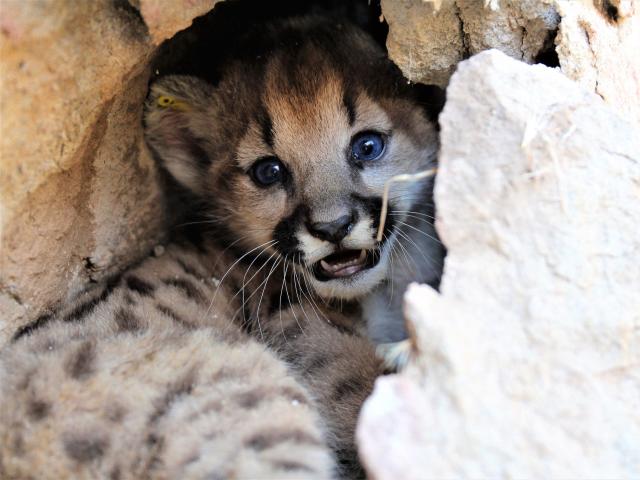
Biologists discovered three mountain lion kittens in a patch of poison oak outside of Los Angeles.
They were only 24 days old when they were found on May 18.
Now, they must survive in an increasingly urbanized area of Southern California.
Biologists with the National Park Service discovered a litter of recently birthed mountain lion kittens in the Simi Hills, west of Los Angeles.
To find the kittens, the biologists had to wait until the mother, P-77, left the site unattended to hunt for food or rest.
Biologists determined that when the kittens were discovered, they were only 24 days old.
"It will be interesting to learn how these kittens will use the landscape once they get older and disperse, particularly if they decide to stay in the Simi Hills or cross freeways to enter larger natural areas." Jeff Sikich, the lead field biologist of the NPS mountain lion study, said in the release.
According to the main findings of the NPS observations, mountain lions in Los Angeles County are significantly threatened by the development of roads and cities. A leading cause of mountain lion deaths are vehicle strikes, which often occur when they cross major freeways like the 101, 405, and 118.
"It's encouraging to see reproduction in our small population of mountain lions, especially after all the mortalities we have documented in the last year," Sikich said in the release.
A 'one-in-ten-million' rare white bison calf was just born in Wyoming
A rare white bison — which some communities find sacred — was born in a Wyoming State Park on Tuesday. Tourist traffic is already increasing.
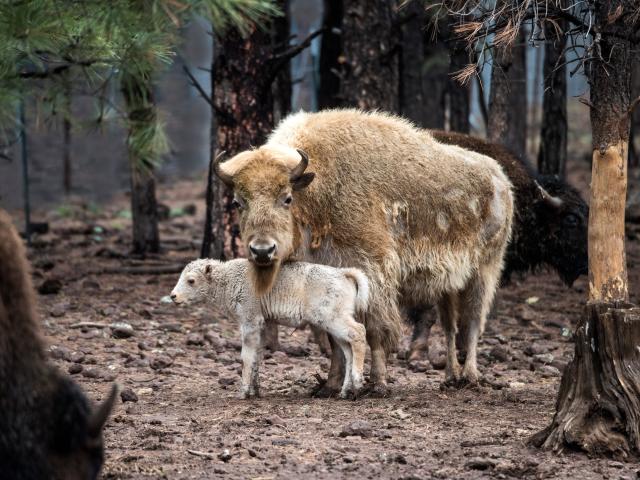
A rare "one-in-ten-billion" albino white bison was born in a Wyoming state park on Tuesday.
White bison are considered sacred to some Native Americans, according to the Native American College Fund.
Bear River Park Superintendent Tyfani Sager said that the calf is small but doing well, Cowboy State Daily reported.
Park Superintendent Tyfani Sager told the outlet the bison is small, but doing well.
Sager said the park has not determined the sex of the bison yet, and that tourist traffic has been up at the park since its birth on Tuesday.
"We're not sure if it's a bull calf or a heifer calf," Sager said, according to Cowboy State Daily. "They're real furry and it's hard to tell right off the bat."
White bison are considered sacred to the Lakota Sioux, who were starving during one summer because there was no game near them, according to the organization. Native legends say that two young men in the tribe went looking for food in the Black Hills of South Dakota, where they met a woman dressed in white who said, "return to your people and tell them I am coming," the organization said in a release.
According to the legend, the woman rolled on the ground four times before turning into a white bison herself. Bison were then plentiful for the Lakota Sioux, the legend says.
The slaughter of a white bison and its mother on a Lakota ranch in 2012 was considered an outrage by others in the community, according to the Native American College Fund.
Wyoming state parks did not immediately return Insider's request for comment on Sunday.
Scientists have discovered over 5,000 new species in the Pacific Ocean, from sea cucumbers to 'gummy squirrels' — check them out
The species were found in a mineral-rich area of the Pacific Ocean floor between Hawaii and Mexico that could be targeted for deep-sea mining.
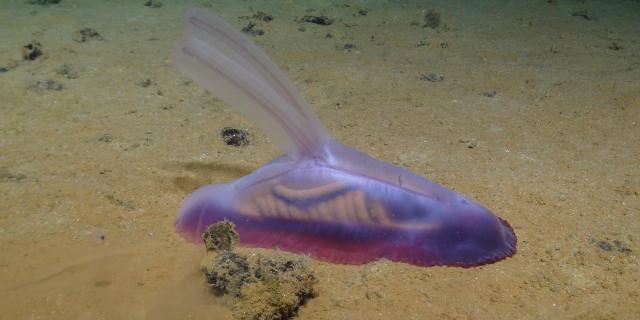
Scientists have discovered thousands of new species in an area of the Pacific Ocean.
They found 5,578 species in the Clarion-Clipperton Zone, a 1.7 million square mile region.
88% to 92% of the creatures that they discovered were "new to science," they said.
Of the 5,578 new species discovered, around 88% to 92% were "new to science," the report says.
The new species were found in the Clarion-Clipperton Zone (CCZ), an area of the ocean floor between Hawaii and Mexico that spans 1.7 million square miles. The area, which is rich in minerals, has been identified as a target zone for future mining, and scientists have set out to research the area's ecosystem before such mining begins.
According to the report, the CCZ was first explored in the 1960s, while informal lists of species were created from the late 1970s to the 1990s.
"In a way, I am surprised about how little we actually know," said Muriel Rabone, a deep-sea researcher at the Natural History Museum and the lead author of the study.
"Considering we have been visiting the CCZ since the 1960s, and it is actually the best-known abyssal region, yet we still know only 10% of species-level diversity," she added.
Scientists were delighted to discover that parrots willingly made video calls to bird friends and were less lonely as a result
Scientists taught parrots to call other birds and were delighted when the parrots started making the calls on their own and chose which birds to call.
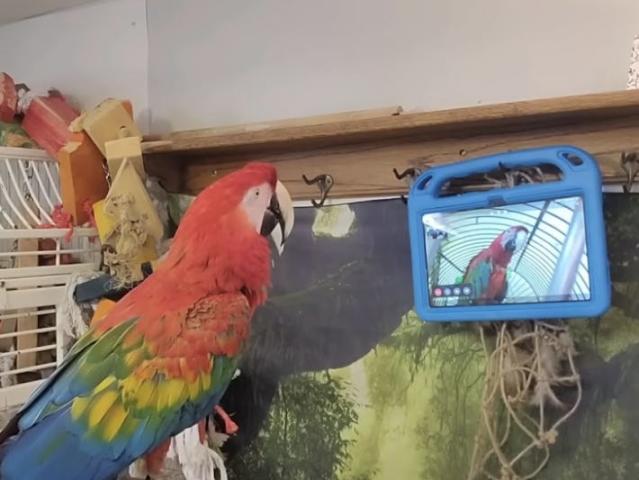
Researchers trained parrots to call certain birds. Later the parrots chose who they wanted to call.
The researchers were delighted when the parrots interacted with each other over the screen.
Scientists had to extensively train bird parents for this exercise. Not just anyone should try it.
Researchers have discovered that parrots are pretty much just like us when it comes to video chatting with friends.
The researchers also told Insider that they were delighted when the parrots on either end of the call interacted with each other by tapping the screen and doing activities together like preening. A sign the birds were bonding.
The study's results are important for the many pet parrots who live alone with their humans and thus may not get their high social needs met.
They tend to pair off within a larger flock of parrots and do most things, like feeding, preening, sleeping, traveling, and raising their young within this social group, Kleinberger and Cunha said.
So, when these birds live alone as pets with minimal social interaction, they have little outlet for many of their cognitive abilities.
Under-stimulated parrots may quickly become bored, frustrated, and lonely. In fact, Cunha said, some countries have made it illegal to keep only one parrot, due to their complex social needs.
The ability to make video calls to other parrots, then, may give birds the chance to access the socialization and species identity they have in the wild, Cunha said.
They then had a training phase where parrots learned to select another bird's photo on a tablet to start a call on Facebook Messenger — which the parrots did successfully in just a couple of weeks.
After that, parrots would ring a bell when they wanted to make a call. When their caregiver offered the tablet, they'd touch the picture of the bird they wanted to chat with.
Initially, the birds were given treats for ringing the bell and selecting a bird "friend," but after the training period, they stopped getting treats. The researchers were happily surprised by how quickly the birds picked up the method for calling one another voluntarily.
Researchers were also delighted to see the parrots engaging with the video calls by following the birds on the other side of the screen, both visually and by directly touching the tablet.
Many birds mirrored behaviors they saw their friends do, like foraging, preening, and flying.
"Throughout the study we observed a diversity of social behaviors, from preening together and sleeping together on-screen to vocalizing," Kleinberger said.
"They developed favorite parrots to call, and most parrots would engage with the system for the maximum amount of time," Hirskyj-Douglas said.
Parrots could make two calls a day, with each call lasting no more than five minutes. The researchers set this time limit for safety and ethical reasons and to minimize the time commitment for caregivers.
Kleinberger added that the sheer number of calls made by the parrots — 147 in all — seemed to support their interest and engagement with the bird on the other side of the screen.
All of the parrot caretakers involved said their bird had a positive experience with video calling, the study said.
Some caretakers said their birds reacted to their video friends the same way they'd react to real people or birds. One caretaker said their bird even called "Come back!" when the other bird walked off-screen.
All but one of the caretakers said they believed their parrot got more out of the video chat than simple enjoyment. For instance, one parrot seemed to gain confidence and began flying more. Others seemed calmer in general, the study said.
The researchers extensively trained the parrot caretakers who participated in the study, Cunha said.
Video calling itself has to be conducted in a sensitive, ethical manner, to slowly introduce the technology and make sure there are no fear reactions, Hirskyj-Douglas added.
Parrot caregivers learned, for instance, to recognize signs of stress during the video calls and offer encouragement to help reduce any fear associated with the new experience.
Caregivers would also end the call if their bird seemed uncomfortable or walked away from the calling zone, Hirskyj-Douglas said. That way, the parrots learned they could simply walk away if they didn't want to interact.
Forced socialization isn't in any parrot's best interest. The researchers released three parrots from the study in its early stages, as these birds didn't seem to like the calls at all.
But most of the parrots apparently enjoyed the experience and chose to make plenty of calls to other birds.
The study authors acknowledge the need for additional research, as this study is the first exploring video calling for parrots. That said, they believe video calling could become an important way to help isolated parrots build and maintain important connections with other members of their species — just as it does for people.
Video may show an octopus waking up from a nightmare, scientists believe
The findings raise questions about the possibility of dream-like experiences in these intelligent creatures.
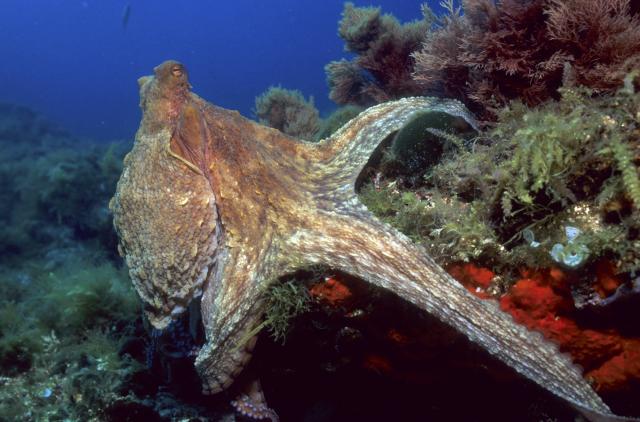
A video shows an octopus appearing to wake up from sleep in distress.
The behaviour looked similar to waking up from a nightmare, scientists said.
The findings raise questions about the possibility of dream-like experiences in the creatures.
Scientists observed unusual behavior in an octopus that they said looked similar to it waking up from a nightmare.
The cephalopod, named Costello, was filmed 24 hours a day in a laboratory at The Rockefeller University in New York over the course of a month.
The behavior suggested that it was in temporary distress, which scientists said could suggest he was responding to a bad dream.
"And then he just got up like nothing had happened, and he resumed his day as normal."
When Costello came to the laboratory from the wild, he appeared to have suffered severe injuries, including losing the majority of two of his arms, which researchers said was likely due to a previous attack. They noted a study that found such cases in animals "can result in long-term behavioral and neural hypersensitivity," suggesting Costello may have been responding to memories of the attack.
The study has not yet been peer-reviewed and only observed one octopus, but the findings have raised questions about the possible dream-like experiences of these intelligent creatures.
One of the study's co-authors noted that it would be difficult to study an octopus' brain activity and determine whether they actually dream.
Another scientist who was not involved in observing Costello said the strange behavior could have another explanation, however.
Robyn Crook, an associate professor of biology at San Francisco State University, told Live Science that the octopus' behavior could have been due to senescence, which is when an octopus' body starts to break down before death.
Costello died shortly after these episodes, according to Live Science.
Crook said that the Costello's movements in the video appeared to be due to a lack of motor control, possibly pointing to senescence.
"I don't exclude that senescence could be one of the drivers of this," Ramos told Live Science.
The study's authors noted that the results couldn't be considered conclusive until replicated. As the episodes in question were fleeting, the scientists recommended that future researchers also observe octopuses for 24 hours a day using cameras.
River Stour: Hundreds take to the water for clean river campaign
Campaigners want bathing water status for the River Stour in the hope it will get cleaned up.

More than 350 people have taken part in a mass swim to support a campaign for bathing water status.
Wild swimmers are applying for the status for the River Stour in Manningtree, Essex, meaning water quality would be monitored.
A total of 369 took to the water on Saturday afternoon, including swimmers, children paddling and those on boats.
Helen Whitehead, who helped organise the event, said: "It goes to show how many people love and use the Stour."
"It's such a precious resource and we must keep it that way," she added.
The Department for Environment, Food and Rural Affairs considers how many people bath there, whether the site has suitable facilities and where investment would have the most impact when making its decision.
Manningtree Beach is impacted by three sewer storm overflows which spill into the Stour, but only one has been monitored by Anglian Water since last April, which recorded eight sewage spills for 15.5 hours last year.
Catherine Arnold, from the S.W.I.M team, said: "People are absolutely fed up with our waterways being polluted and they want action to stop it. We'll keep going until we know we can swim and use the river safely."
If the application is successful, the Environment Agency will take regular samples during the bathing season to give swimmers a clearer picture and to assess whether action is needed.
Anna Helm Baxter, from the campaign, said: "Bathing designation helps the public make informed decisions about where to enjoy our inland waterways safely. It will help us hold polluters to account."
More than 400 coastal locations around the UK have been given the designation, but this only includes a handful of rivers. Only 14% of rivers are considered ecologically healthy in England, according to The Rivers Trust.
Sir Bernard Jenkin, MP for Harwich and North Essex, swam during the event and said he fully supported the campaign.
"I'll take the message back to the government. I've always enjoyed wild swimming and it is everyone's right to swim in clean water.
"Rivers should be as nature intended, not used as waste receptacles for our society," he said.
An Anglian Water spokesperson previously said: "We're already working alongside community groups on several rivers in our region who are keen to apply for bathing designations, to help them monitor local water quality and understand other factors which contribute to river health."
0 Likes
